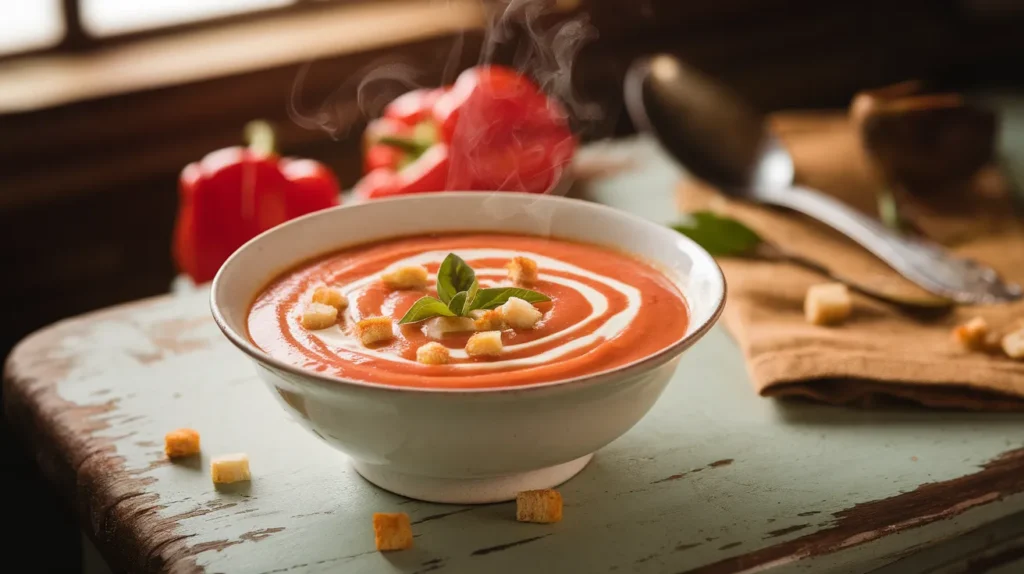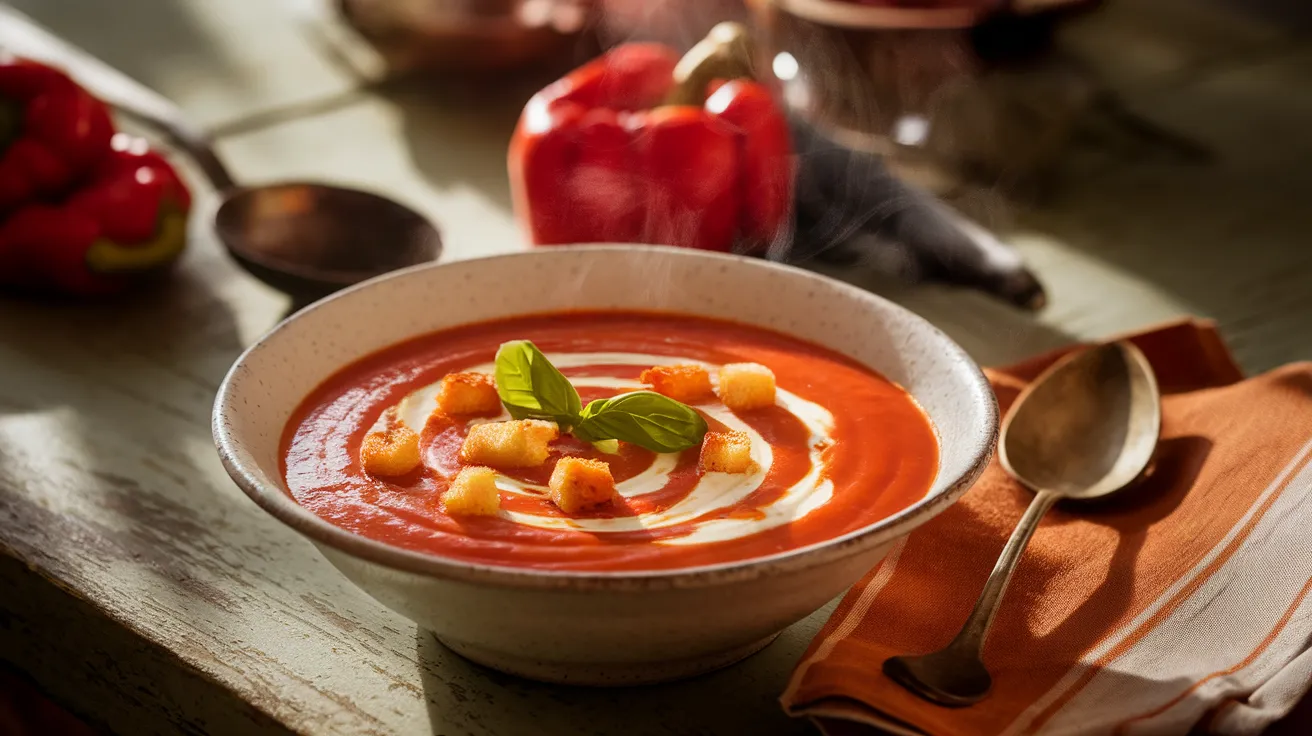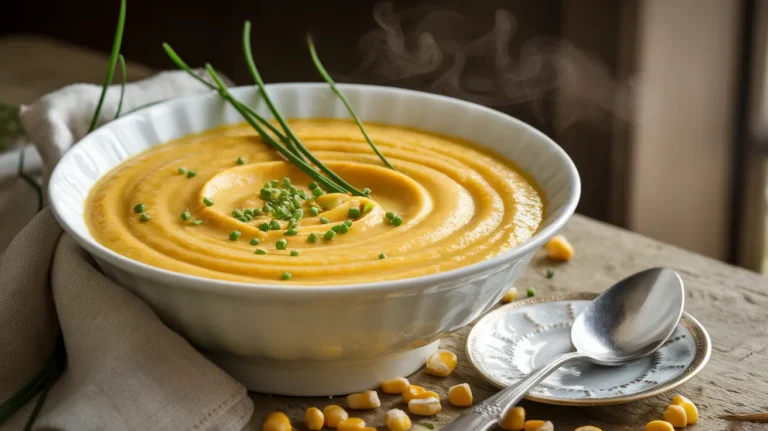This roasted red pepper soup brings restaurant-quality flavor to your kitchen with sweet charred peppers, creamy texture, and a hint of smokiness. Perfect for cozy dinners, this roasted red pepper soup delivers comfort in every spoonful while being surprisingly simple to master.
SERVES: 4 | PREP: 20 MIN | COOK: 45 MIN | TOTAL: 65 MIN
Ingredients
For the Roasted Peppers
| Ingredient | Amount |
|---|---|
| Red bell peppers | 6 large |
| Olive oil | 2 tablespoons |
| Salt | 1 teaspoon |
For the Soup Base
| Ingredient | Amount |
|---|---|
| Yellow onion (diced) | 1 large |
| Garlic cloves (minced) | 4 cloves |
| Olive oil | 3 tablespoons |
| Smoked paprika | 1 tablespoon |
| Tomato paste | 2 tablespoons |
| Vegetable broth | 4 cups |
| Heavy cream | ¾ cup |
| Fresh basil leaves | ½ cup packed |
| Salt | To taste |
| Black pepper | To taste |
For Garnish
| Ingredient | Amount |
|---|---|
| Sour cream | ¼ cup |
| Fresh basil | 4 sprigs |
| Croutons | ½ cup |
Step-by-Step Instructions
Phase 1: Roasting the Peppers (20 minutes)
Step 1: Set your oven to broil on high heat. Position the oven rack about 6 inches from the heating element. This distance is critical—too close and the peppers will burn before softening, too far and they won’t char properly.
Step 2: Prepare the peppers for roasting. Wash the peppers and pat them completely dry with paper towels. Place them whole on a large baking sheet lined with foil. Rub each pepper with olive oil and sprinkle with salt. The oil helps the skin blister while the salt draws out moisture for better charring.
Step 3: Broil the peppers, turning every 5 minutes. Watch for the skin to bubble and blacken in patches—this is exactly what you want. Turn each pepper with tongs so all sides get evenly charred. The whole process takes about 15-20 minutes. Your kitchen will smell incredible.
Step 4: Steam the peppers in a covered bowl. Transfer the hot peppers immediately to a large bowl and cover tightly with plastic wrap. Let them sit for 10 minutes. The trapped steam loosens the skins, making them peel off like magic.
Step 5: Peel and deseed the peppers. Once cool enough to handle, slip the skins off with your fingers—they should come off easily. Remove the stems and seeds. Don’t rinse the peppers under water; you’ll wash away that smoky flavor you worked hard to create. A few dark bits are fine and add character.
Phase 2: Building the Soup Base (15 minutes)
Step 6: Sauté the onions until golden. Heat 3 tablespoons of olive oil in a large pot over medium heat. Add the diced onion. Cook for 8-10 minutes, stirring occasionally, until the onions turn soft and golden brown around the edges. This caramelization adds natural sweetness to balance the peppers.
Step 7: Add garlic and let it bloom. Toss in the minced garlic and stir constantly for 60 seconds. You’ll smell it turn fragrant—that’s your cue. If it starts browning too fast, lower the heat. Burned garlic tastes bitter and will ruin your soup.
Step 8: Stir in smoked paprika and tomato paste. Add both ingredients and stir for 2 minutes, coating the onions completely. The tomato paste will darken slightly and smell sweeter—this cooking process removes the raw, tinny flavor and concentrates the umami. The smoked paprika adds depth that complements the charred peppers beautifully.
Phase 3: Simmering and Blending (25 minutes)
Step 9: Add the roasted peppers and broth. Roughly chop your peeled peppers and add them to the pot along with the vegetable broth. Stir everything together and bring to a boil over high heat.
Step 10: Reduce heat and simmer. Once boiling, lower the heat to medium-low so the soup gently bubbles. Let it simmer uncovered for 20 minutes. This allows the flavors to marry and the peppers to break down further. Stir every 5 minutes to prevent sticking.
Step 11: Add fresh basil before blending. Turn off the heat and tear the basil leaves directly into the soup. Fresh basil loses its bright flavor when cooked too long, so adding it now preserves that herbal brightness.
Step 12: Blend until silky smooth. Use an immersion blender directly in the pot, blending for 2-3 minutes until no chunks remain. If using a countertop blender, work in batches and fill only halfway to prevent hot soup from exploding out. Hold the lid down with a folded kitchen towel for safety.
Phase 4: Finishing Touches (5 minutes)
Step 13: Stir in the heavy cream. Return the pot to low heat if needed. Slowly pour in the cream while stirring. The soup will turn from bright red to a gorgeous peachy-coral color. This also mellows any sharp acidity from the peppers.
Step 14: Season to perfection. Taste your soup and add salt and black pepper gradually. Start with ½ teaspoon of salt, stir, taste, and repeat. The right amount of salt makes all the flavors pop. If the soup tastes flat, it needs more salt. If it’s too thick, thin with extra broth.
Step 15: Serve hot with garnishes. Ladle the soup into four bowls. Add a dollop of sour cream, a fresh basil sprig, and a handful of croutons to each. The cool sour cream contrasts beautifully with the warm soup.
Chef’s Notes
Pepper Selection Matters: Choose peppers that feel heavy for their size with tight, glossy skin. Wrinkled peppers are older and won’t roast as well. The flavor of your roasted red pepper soup depends entirely on quality produce.
Control the Heat: If you prefer a spicier version, add ¼ teaspoon of red pepper flakes when you add the smoked paprika. The oil will bloom the spices and distribute the heat throughout.
Cream Alternatives: For a lighter version, swap heavy cream with full-fat coconut milk. It adds richness without dairy and gives a subtle tropical note that works surprisingly well with roasted red pepper soup.
Smoky Depth: If you want more smokiness, add a drop of liquid smoke or roast one jalapeño alongside the bell peppers. Remove the seeds unless you want heat.
Nutrition Information (Per Serving)
| Nutrient | Amount |
|---|---|
| Calories | 285 |
| Protein | 5g |
| Carbohydrates | 22g |
| Fat | 21g |
| Fiber | 4g |
| Sugar | 12g |
| Sodium | 680mg |
Creative Variations
Spicy Southwest Style: Add a can of fire-roasted tomatoes, cumin, and chipotle powder for a Mexican-inspired twist. Top with crispy tortilla strips and avocado.
Creamy Tomato Fusion: Combine this technique with a classic tomato soup recipe by adding fresh tomatoes during the simmering phase for a richer, more complex flavor profile.
Fall Harvest Version: When autumn arrives, try adding roasted butternut squash alongside the peppers. The sweetness pairs wonderfully, similar to how this creamy pumpkin soup combines sweet vegetables with savory elements.
Mediterranean Goddess: Stir in ¼ cup of sun-dried tomatoes, crumbled feta cheese, and fresh oregano. Serve with grilled pita wedges for dipping.
Storage & Reheating
Refrigerator Storage: Let the soup cool completely before transferring to an airtight container. It keeps for 5 days in the fridge. The flavors actually deepen overnight, making leftovers even better.
Freezer Storage: This soup freezes beautifully for up to 3 months. Portion into individual freezer-safe containers, leaving 1 inch of headspace for expansion. Skip adding the cream until after thawing and reheating.
Reheating Instructions: Warm on the stovetop over medium-low heat, stirring frequently to prevent scorching. Add a splash of broth if it’s too thick. Microwave individual portions in 1-minute intervals, stirring between each.
Make-Ahead Tip: Roast the peppers up to 3 days ahead and store them peeled in the fridge. This cuts your cooking time nearly in half on busy nights.

Troubleshooting Common Problems
Problem 1: Soup tastes bitter Your peppers got too burned, or the garlic scorched. Next time, broil a bit farther from the heat and watch the garlic carefully. Fix the current batch by adding 1-2 teaspoons of sugar or honey to balance the bitterness.
Problem 2: Soup is too watery You added too much broth or didn’t simmer long enough to reduce. Simmer uncovered for an additional 10-15 minutes to evaporate excess liquid. The soup should coat the back of a spoon.
Problem 3: Grainy or chunky texture Your blender didn’t run long enough. Keep blending for at least 3 full minutes. For the silkiest result, strain through a fine-mesh sieve after blending, though this removes some fiber.
Problem 4: Cream separated or looks curdled The soup was too hot when you added the cream, or you used low-fat cream. Always temper cold cream by whisking in a ladle of hot soup first, then slowly add the mixture back to the pot while stirring.
Problem 5: Not enough smoky flavor Your oven wasn’t hot enough, or the peppers didn’t char sufficiently. Make sure the broiler is fully preheated. For immediate fixing, add ¼ teaspoon of smoked paprika or 2-3 drops of liquid smoke.
Equipment Essentials
- Large baking sheet with foil
- Tongs for turning peppers
- Large mixing bowl with plastic wrap
- Heavy-bottomed soup pot (6-quart)
- Sharp chef’s knife
- Cutting board
- Immersion blender or countertop blender
- Ladle
- Measuring cups and spoons
- Wooden spoon or silicone spatula
Shopping List
Produce Section:
- Red bell peppers (6 large)
- Yellow onion (1 large)
- Fresh garlic (1 bulb)
- Fresh basil (1 bunch)
Dairy Section:
- Heavy cream (1 pint)
- Sour cream (1 small container)
Pantry Aisle:
- Olive oil
- Smoked paprika
- Tomato paste (small can)
- Vegetable broth (32 oz carton)
- Salt and black pepper
- Croutons
Success Secrets
1. Char deeply, but don’t carbonize The peppers should have large black blistered patches covering 60-70% of the surface. A little char is flavorful; completely blackened peppers are acrid.
2. Use quality broth Since this soup has few ingredients, each one matters. Cheap broth tastes salty and artificial. Look for low-sodium varieties with actual vegetable content listed in the first three ingredients.
3. Balance sweetness and acidity Red peppers are naturally sweet when roasted. If your soup tastes one-dimensional, add 1 tablespoon of balsamic vinegar or fresh lemon juice to brighten everything up.
4. Blend while hot Hot ingredients blend smoother than cold ones. The heat helps break down the pepper fibers for that restaurant-quality silky texture you’re after.
5. Season in stages Add salt three times: when roasting peppers, after blending, and before serving. This builds layers of seasoning rather than one salty punch at the end. Your taste buds will notice the difference.
This roasted red pepper soup proves that simple ingredients, treated right, create extraordinary results. The charred sweetness, creamy body, and smoky undertones make this a recipe you’ll return to again and again.




